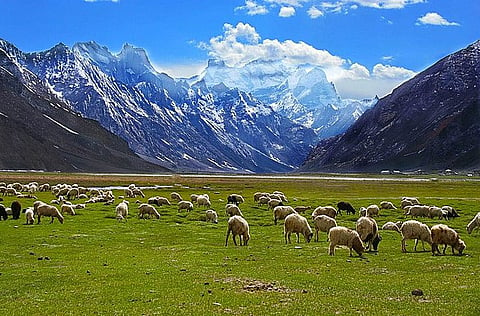
- Topics
- Feature
- Opportunities & Events
- About
- Hindi Portal
- Data
- Topics
- Feature
- Opportunities & Events
- About
- Hindi Portal
- Data

Traditional institutions aid community survival in hard times
Indigenous communities have long managed their ecology, environment and food security and livelihood needs through traditional knowledge and institutions guided by socio-cultural norms, values, sacred beliefs, taboos and codes of conduct. These institutions help in survival of communities in times of limited resources, fragile environments, low productivity and uncertain external environments by building resilience and enhancing adaptability to changing conditions.
However, urbanisation, sociopolitical changes coupled with climate change are providing new set of challenges to these institutions and threatening the existing traditional knowledge and practices informs this paper titled 'Local institutions in Ladakh, India: community-based resource management in mountain agropastoralism' in Current Science.
Fragile mountain ecosytems of Ladakh
This is especially true in the context of mountain ecosystems such as that of Ladakh, India, where geographic isolation and biophysical constraints affect the lifestyles and survival of people in the region. Traditional agropastoral practices include cultivation of crops like barley, wheat and vegetables, and tree farming. People also practice animal husbandry along with agriculture ensuring food and fodder security.
Local institutions, such as goba (village head), chhurpon (water management), primogeniture system for land management, and other institutions such as droksa (summer pasture settlement), tsogs (forest groves), phaspun (social affiliation) and amchi (for healthcare) help people in the region cope with vagaries of nature and in sustainable resource management. These institutions are integral to sociocultural, economic and religious fabric of communities in Ladakh and form a self-regulatory system, extending to landscape-level management, such as irrigation water management.
The study describes the traditional institutions and their role in farming systems in the Leh valley, and explores the impact of urbanisation on survival of these institutions for sustainable resource management.
Agriculture and traditional institutions in Ladakh
People in Ladakh practise combined farming, integrating various agroforestry systems such as silviculture, agrosilviculture, silvi-pastoral, silvi-horticultural and agrohorti-silvicultural, along with livestock rearing. Management of resources is done through diverse land-tenure systems, including individual, community and institutional (such as monasteries and the Forest Department) ownership. Key roles in this management include the goba, chhurpon or chhurez, lorapa and lurhupa, with specific monastery positions managing their respective resources.
Goba system
Includes a goba – a selected person in the village, an assistant, and a kutual (messenger), who are all recognised under the Jammu and Kashmir Lambardari Act (1972). The goba oversees and manages village matters through thims (customary laws), resolves conflicts, and communicates decisions from dusa/dzomsa meetings, involving all households (yulpa). The goba system also forms a connection between the village, monastery and various agencies and monitors other resource management institutions. However, this system is under threat due to Panchayat Raj system and technological advancements affecting its role in village decision-making and fair and equitable management of resources.
Lorapa system
Lorapas enforce regulations on free grazing of livestock, including yaks, dzos and cows, within the village boundaries and are annually selected during the cropping season, from March–April to August–September, with specific terms, conditions, and penalties established during the process. Disputes involving lorapas are resolved by the goba. However, traditional livestock rearing of sheep and goats has declined in recent years and is being replaced by practices such as milching cows like jerseys and hybrids.
Lurhupa system
The lurhupa plays a crucial role in protecting plantations from livestock, managing irrigation, repairing mud walls and maintaining plantation sites. The number of lurhupas is determined by the size of the plantation. In the present study, lurhupas from the local villages managed plantations owned by Hemis Monastery, with these households granted access to plantation resources in return for their services.
However, reduced local engagement, driven by alternative livelihood opportunities, has led to the recruitment of lurhupas from outside the local community and is weakening the traditional ties between villagers and the monastic institution, leading to a decrease in the number of local lurhupas and an increase in external participation. Nevertheless, practices such as irrigation, fencing and pollarding/lopping continue to be observed among the local lurhupas.
Role of local institutions has reduced over time
The study finds that:
The role of local institutions in natural resource management has significantly reduced in recent years in Ladakh. Government policies, market dynamics, tourism and new livelihood opportunities are leading to this along with growing accessibility to markets and ration stores which is reducing reliance on traditional farming.
Population growth and a shift towards non-agricultural sectors are also affecting the survival of these institutions along with changes in diet, increased market dependency, employment of agricultural labourers, tractor use and reduced participation in traditional agricultural festivals.
The increase in demand is further impacting the umbrella goba system and related institutions. For example, the lorapa system has shifted to a rotational selection with monetary penalties for defaulters. Changes in livestock composition, practices such as fencing have reduced the need for active lorapa involvement.
The study finds that local institutions, despite facing socio-economic challenges, can play an indispensable role in sustainable resource management in fragile regions such as Ladakh.
Preservation and strengthening of these systems is vital for sustainable development and crucial for food security, social cohesion and livelihoods in the region. Thus, enhancing their effectiveness will require focus on dealing with factors hindering the sustainability of these institutions, capacity building, and making efforts to integrate these institutions into formal systems in the face of regional, socio-economic and environmental challenges.